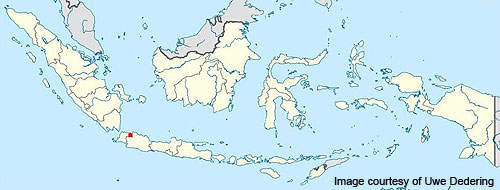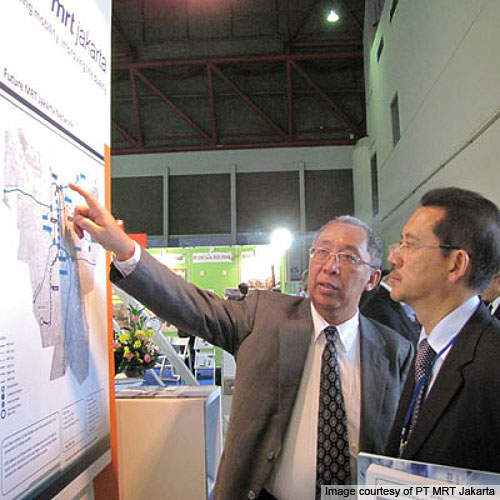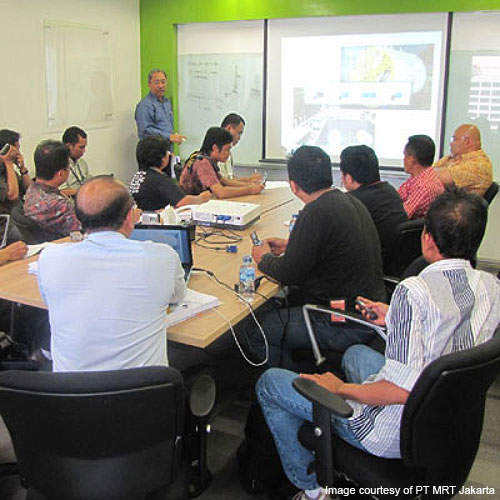The government of Jakarta, Indonesia, commenced construction of its first mass rapid rail transport system in October 2013. The new commuter rail project will stretch approximately 110.3km and involve construction of the north-south and the east-west corridors.
The project is being implemented by the provincial government Daerah Khusus Ibukota (DKI) Jakarta through the land transportation authority PT Mass Rapid Transit Jakarta (PT MRT Jakarta), who will also be the operator of the system.
Estimated to cost JPY144bn ($1.78bn), the project is being funded by Japan International Cooperation Agency (JICA) to the tune of JPY120bn ($1.49bn) while the national and city governments will contribute the remaining amount in proportion of 42% and 58% respectively.
As of April 2011, DKI Jakarta had secured 42% of the JICA loan amount that was granted to the provincial government of DKI Jakarta.
Project background
The project aims to address the growing number of traffic jams in the city. Roads in Jakarta grow at a rate less than 1% a year while more than 1,000 new automobiles a day are launched on the city streets. According to the study conducted by JICA in 2004, Jakarta will face a total road jam in 2020 if the transportation infrastructure is not improved.
In another independent research conducted in 2005, it was estimated that the economic losses incurred due to the traffic jams amount to IDR12.8tn ($1.49bn) a year, including the cost of valuable time, fuel and health. In addition, automobile pollution accounts for 80% of the city’s total population.
Project details
The north-south corridor will be 23.3km-long, and run between Lebak Bulus in south and Kampung Bandan in north of Jakarta. It will be built in two phases.
Phase one will comprise 15.2km rail line from Lebak Bulus to Bundaran HI, located in the centre of the city. It was originally planned to begin from Lebak Bulus to Dukuh Atas (14.5km). The route was, however, modified in July 2010 and extended by additional 1.3km to Bundaran HI as the availability of wide roads in these areas would facilitate easy construction without causing much traffic delays. Moreover, most of the working population is concentrated in this part of the city and hence was necessary to bring this route first into operation.
Of the total length, 9.2km of the rail track will be elevated and 6km will be underground. Phase one engineering and design process started in November 2009 and was completed in January 2011. DKI Jakarta called for pre-qualification of bidding in April 2011 to begin construction in 2012. It intends to complete and begin operating Phase I by 2019.
Phase two will extend the route further by 8.1km from Bundaran HI to Kampung Bandan. This line will be built completely underground. Finalisation of the environmental impact assessment (EIA) is underway. It has been scheduled to open in January 2018.
The east-west corridor is expected to be approximately 87km-long and expected to become operational between 2024 and 2027. Two alternate routes have been suggested for this corridor. The first alternative route is located in the centre of the city from Ke Tamgerang-Balaraja in the west to Ke Cikarang in the east. This route is currently underway; a feasibility study began in April 2011. The second alternative route is in the south of Jakarta, between Ke Bekasi in the east and Ke Balaraja in the west.
Infrastructure
Phase one of the north-south corridor will have 13 stations, seven of which will be elevated and six will be underground. Phase II will have eight underground stations.
Elevated stations will be constructed at Lebak Bulus, Fatmawati, Cipete Raya, Haji Nawi, Blok A, Blok M and Sisingamangaraja. Underground stations will be constructed at Bund.Senayan, Istora, Benhil, Setiabudi, Dukuh Atas, Bundaran HI, Kebon Sirih, Harmoni, Glodock, Kota and Kampung Bandan.
The north-south corridor will have six interchange stations along the 23.3km-long route. Stations that will serve as interchanges include Lebak Bulus, Blok M, Dukuh Atas , Kebon Sirih, Kota and Kampung Bandan. Kebon Sirih will also serve as an interchange station for the east-west corridor.
The 15.2km route will be commuted in 30 minutes with stations placed at distance between 0.5km and 2km.
Trains will operate at headway of five minutes with a target to provide transportation services to 412,700 people after the first three years of operation for Phase I and 629,900 people for Phase II in 2037.
Contractors involved
Sumitomo was awarded a JPY13bn contract to deliver 96 subway cars for phase one of the north-south corridor of the project.
A consortium of Mitsui, Toyo, KOBELCO and IKPT received a contract from Mass Rapid Transit Jakarta to integrate railway systems and trackwork for the North-South corridor.
Mitsui will act as the consortium leader, while Toyo will provide project management and designing, as well as various equipment.
KOBELCO is responsible for providing the signalling and communication systems, and fare collection systems.
IKPT will equip all the systems for the project.
Ramco Systems secured a contract to deploy regional finance and accounting functions of its ERP suite.





